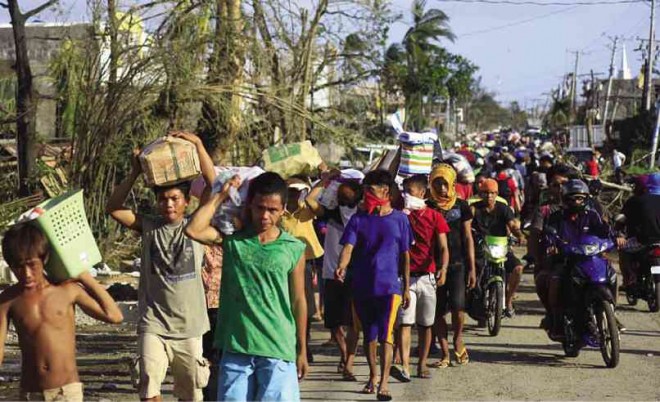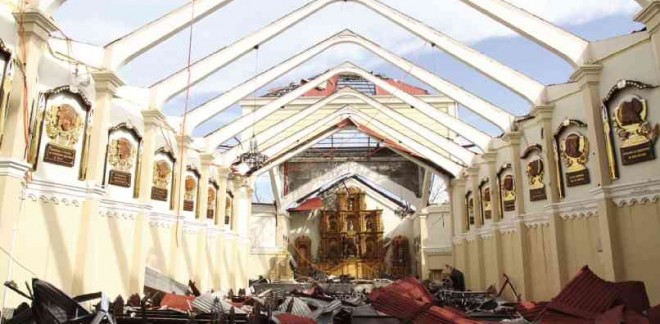Aquino declares state of national calamity
Tacloban City is reduced to vast wasteland after the onslaught of super typhoon “Yolanda.” Video by INQUIRER.net’s Ryan Leagogo
President Aquino on Monday night declared a state of national calamity, three days after Supertyphoon “Yolanda” roared across the central Philippines, killing hundreds of people and leaving the region, in the words of a US military official, totally devastated.
“We declared a state of national calamity to expedite the government’s rescue, relief and rehabilitation efforts in provinces devastated by Yolanda,” Aquino said in a televised address to the nation.
The state of national calamity will remain in force until lifted by the President, according to Proclamation No. 682.
Article continues after this advertisementAquino approved the release of P1.1 billion in additional “quick response fund” for both the Department of Social Welfare and Development (DSWD) and the Department of Public Works and Highways (DPWH).
Article continues after this advertisementThe President said the amount would be added to the P18.7-billion fund that the government had released to help the typhoon victims. It would be sourced from the government’s calamity funds, contingency funds and savings, Aquino said.
“In the coming days, you can expect help to arrive [faster],” Aquino said, addressing typhoon survivors.
Cooperation and prayer would help the nation “rise from this disaster,” the President said.
“Let us show the heart of the Filipino, who will never be brought to his knees by any typhoon,” he added.
The proclamation will “hasten the rescue, recovery, relief and rehabilitation efforts of the government and the private sector, including any international humanitarian assistance,” Aquino said.
As of Monday, he said 22 countries had pledged assistance, among them Indonesia, the United States, England, Japan, Singapore, New Zealand and Hungary.
Price controls
The proclamation would also control the prices of basic goods and commodities in the typhoon-ravaged areas of the country and allow the government to use as much funds as necessary to deal with the calamity caused by Yolanda.

LATTER-DAY EXODUS. Carrying what little remains of their earthly belongings, residents of Tacloban City, Leyte province, evacuate their homes after Supertyphoon “Yolanda” devastated the city. ALVIC ESPLANA/INQUIRER SOUTHERN LUZON
In signing the proclamation, Aquino also directed law-enforcement agencies, with help from the military, to take all necessary measures to ensure law and order in the provinces devastated by the typhoon.
It was the third time in three years that Aquino had placed the country under a state of national calamity.
The first time was on Dec. 20, 2011, after Tropical Storm “Sendong” devastated northern Mindanao and killed 1,080 people.
On Dec. 7, 2012, Aquino declared a state of national calamity in response to Typhoon “Pablo,” which killed 1,900 people in Mindanao.
Supertyphoon “Yolanda” (international name: Haiyan) slammed into the Samar-Leyte area on Friday, then swept across central and western Visayas, leaving wide swaths of devastation.
‘Total devastation’
A US Marine general on Monday said he saw bodies everywhere during a helicopter flight over the region struck by Yolanda.
Speaking after a two-hour flight with Filipino forces, US Marine Brig. Gen. Paul Kennedy said every building and house he saw was destroyed or severely damaged.
“We saw bodies everywhere,” he said. Some were floating in the water, others in a schoolyard, he said.
Kennedy said trees were uprooted for kilometers around, roads were impassable and power lines were down.
“I don’t believe there is a single structure that is not destroyed or severely damaged in some way,” he said.
“I don’t know how else you can describe total devastation,” Kennedy said at the airport in hardest-hit Tacloban City.
Two US Marine C-130 cargo planes were parked nearby, their engines running, unloading food and water from the capital, Manila.
‘Situation is bad’
Three days after Yolanda, the strongest storm on record, roared across the Visayas, government officials still did not know the extent of the damage and devastation, with some in Manila questioning five-figure local estimates.
“The situation is bad, the devastation has been significant. In some cases the devastation has been total,” Cabinet Secretary Rene Almendras told a news conference on Monday.
Interior Secretary Mar Roxas said it appeared that Yolanda whipped Eastern Samar harder than Leyte, adding that the government was rushing relief for the survivors through the airport in Guiuan town.
Reports trickled over the weekend indicating deaths in Eastern Samar.
Leo Dacaynos of the Samar provincial disaster council said on Sunday 300 people were confirmed dead in one town and another 2,000 were missing, with some towns yet to be reached by rescuers.
Dacaynos pleaded for food and water, adding that power was out and there was no cell phone signal, making communication possible only by radio.
Reports from other affected islands indicated dozens, perhaps hundreds, more deaths.
Death toll unclear

NO SANCTUARY HERE. Even the Metropolitan Cathedral in Palo, Leyte province, was not spared from the fury of Supertyphoon “Yolanda” that peeled off the cathedral’s roof and ceiling. NIÑO JESUS ORBETA
With communications still knocked out in many areas, it was unclear how authorities were arriving at their estimates of the number of people killed, and it will be days before the full extent of the storm is known.
In Tacloban, corpses hung from trees, were scattered on sidewalks or buried in flattened buildings, some by the typhoon that washed away homes and buildings with powerful winds and giant waves.
The government has not confirmed officials’ estimates over the weekend of 10,000 deaths, but the toll from Yolanda, one of the strongest typhoons ever recorded, is clearly far higher than the current official count of 1,774 people dead and 2,500 others missing throughout the region.
Philippine National Police Director General Alan Purisima on Monday sought an explanation from Eastern Visayas police director, Senior Supt. Elmer Soria, who was quoted by the wire services on Sunday as saying the death toll in Leyte could reach 10,000.
“We are still verifying the figure (Soria) mentioned. We are actually taking the actual numbers because what we want to report is the actual body count,” Purisima told a news conference at PNP headquarters in Camp Crame, Quezon City.
“If the PNP released a report, we could not take it back. What if (only) 100 people had actually died? Where are the (other) 9,900 bodies?” Purisima said. “The police must only rely on evidence, (or in this case), actual body count. We do not rely on perception reports or anecdotal reports.”
Soria did not report that 10,000 people in Leyte were killed during the typhoon.
The wire services quoted him as saying he was briefed late Saturday by Leyte Gov. Dominic Petilla and told that there were about 10,000 deaths in the province, mostly by drowning and from collapsed buildings.
Petilla’s figure was based on reports from village officials in areas where Yolanda first hit land on Friday.
But Purisima said the provincial police office had yet to provide photographs or other physical evidence that would support that figure.
“The problem is our police stations there cannot contact other police offices. Our ground commanders [have to travel from one town to another then report wherever there is power and telephone],” Purisima said.
He said, however, that radio communication systems were being set up in police offices in typhoon-ravaged communities.
Purisima reminded police commanders that only the National Disaster Risk Reduction and Management Council (NDRRMC) had the authority to release damage and casualty reports during disasters.
“Our (standard operating procedure) is that we should be factual in our reports. We should not be speculating,” Purisima said.
“Policemen can make public their report on the number of casualties [but it] should be based on what they had actually seen,” he said. “We are not trying to hide anything here, but what we want is accurate reporting.”
Communications down
That is proving difficult, though, as much of the central Philippines remains cut off from communications.
The United Nations said officials in Tacloban, which bore the brunt of the typhoon on Friday, had reported one mass grave of 300-500 bodies.
More than 9 million people were affected by the storm across the country and many have no access to food, water, or medicine, the DSWD and the United Nations say.
Flattened by surging waves and monster winds of up to 250 kilometers per hour, Tacloban, 580 km southeast of Manila, was relying almost entirely for supplies and evacuation on just three military transport planes flying from Cebu City, across the Camotes Sea in Central Visayas.
Most of the damage and deaths were caused by huge waves that inundated towns and swept away coastal villages in scenes that officials likened to the 2004 Indian Ocean tsunami. Bodies were littered on the streets of Tacloban, rotting and swelling under the hot sun and adding to the health risk.
International aid agencies said relief resources in the Philippines were stretched thin after a 7.2-magnitude earthquake in Central Visayas last month and displacement caused by fighting between government forces and Moro National Liberation Front (MNLF) rebels in Zamboanga City in September.
Operations were hampered because roads, airports and bridges had been destroyed or were covered in wreckage.
Energy Secretary Jericho Petilla said on Monday that it would take at least two months to restore power in the region.
Petilla said more than 100 power pylons were toppled during the typhoon. Even if they were erected again, he said, power distribution could not resume right away because of lack of materials and manpower.
Threatening to add to the crisis, a tropical depression carrying heavy rain was forecast to arrive in the region as early as Tuesday.
In central and western Visayas, the death toll from Yolanda had risen to 235 while the damage to infrastructure and agriculture had been estimated at nearly P800 million, disaster officials said on Monday.
In western Visayas, the death toll was 176, of which 133 were reported in Iloilo, 25 in Capiz, 12 in Antique, and one in Negros Occidental.
Officials said they expected the figures to rise as fresh reports of body recovery came in.
The Capiz provincial disaster council said most of the deaths were from drowning, collapsed houses, flying debris or falling trees.
In central Visayas, the regional civil defense office said the death toll was 59 as of Monday.
A regional civil defense officer, Flor Gaviola, said 58 of the deaths were reported in Cebu and one in Guindulman, Bohol province.
Gaviola’s office still had to determine the extent of the damage to infrastructure and agriculture Yolanda had inflicted on the region.
More bodies recovered
In Estancia town, Iloilo province in Western Visayas, municipal officials reported on Monday that 71 bodies had been recovered, more than half of the 133 fatalities reported for the entire province.
The bodies, including those of 25 fishermen believed to be from Masbate province, were buried in mass graves on Sunday.
The fishermen were killed after their boats, anchored at the port of Estancia, slammed into the seawall by a huge storm surge.
There will be more burials in coming days.
“We are still fishing bodies out of the sea,” said Erol Acosta, Estancia budget officer.
Edilberto Tayao, Western Visayas director of the DPWH, said the region recorded P600 million in damage to infrastructure.
The regional office of the Department of Agriculture estimated the damage to agriculture in the area at P99.23 million.—With reports from Dona Z. Pazzibugan in Manila; Nestor P. Burgos Jr., Felipe Celino, Jhunnex Napallacan and Carla Gomez, Inquirer Visayas; Matikas Santos, INQUIRER.net; and wires
Originally posted: 7:10 pm | Monday, November 11th, 2013